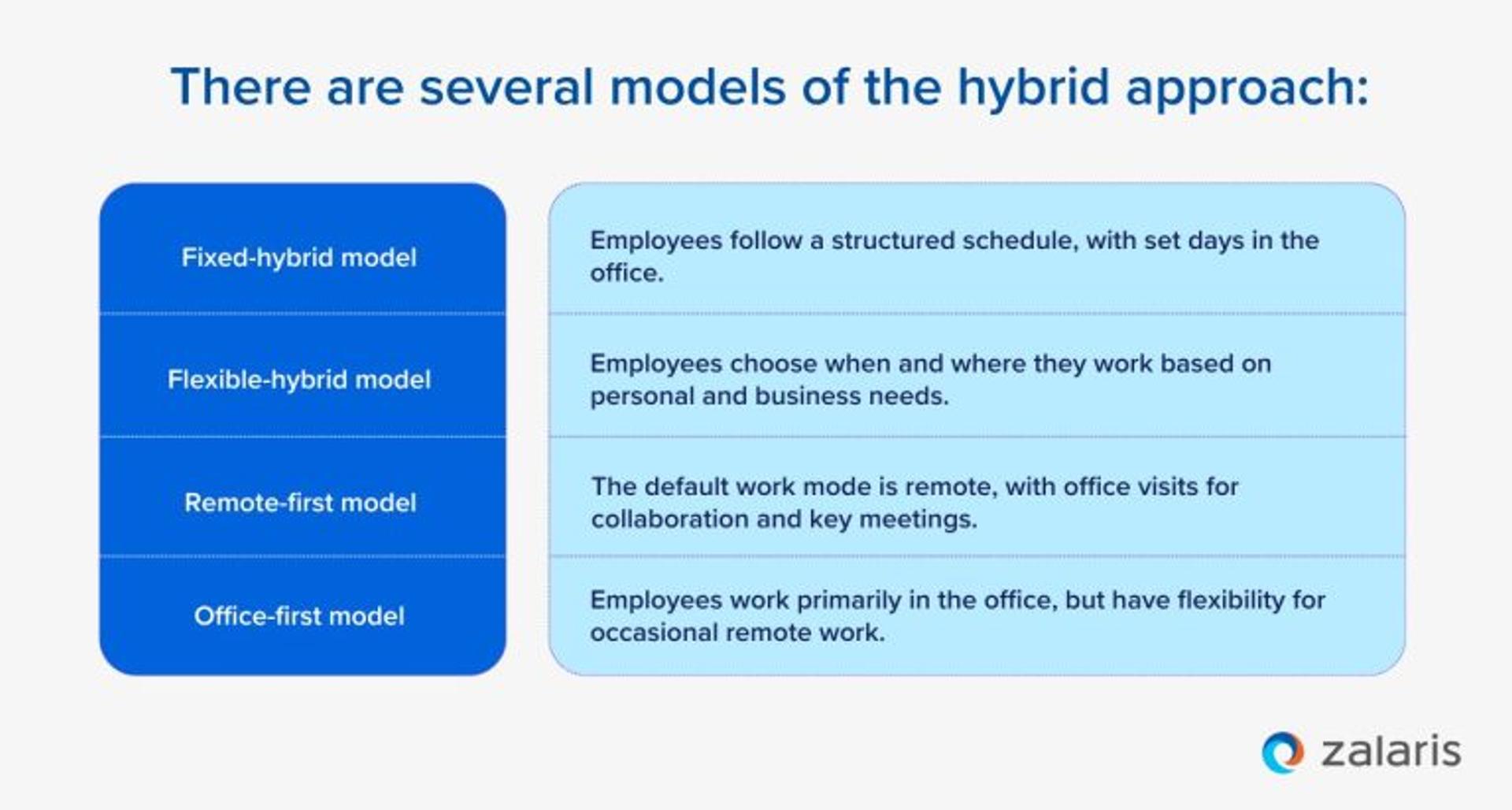The hybrid approach to workplace management: Balancing flexibility and efficiency
The hybrid approach has reshaped the modern workplace - and caused heated discussions. For many, blending remote and in-office work enhances flexibility, productivity, and employee satisfaction. For others, it presents challenges in communication, collaboration, and work-life balance.
Elliot Raba

For HR decision-makers, implementing a hybrid work model requires strategic planning, establishing clear policies, and choosing the right HR technology.
A thoughtful strategy can balance the flexibility that remote work offers and the collaborative benefits of in-office work. This article explores these best practices that help HR teams align organisational efficiency with employee wellbeing and business goals.
Understanding the hybrid work model
The hybrid working model combines remote and in-office work, allowing employees to choose where they are most productive. While the concept existed before, it surged in popularity after the COVID-19 pandemic, which forced organisations worldwide to adapt to remote work.
Today, remote work has seamlessly integrated into current practices. According to the Office for National Statistics (ONS), 28% of working adults in the UK were working in a hybrid model in 2024, indicating this approach’s positive impact on employee engagement and business resilience.
There are several models of the hybrid approach:

Each model presents unique challenges and opportunities. To succeed, HR leaders must define expectations, establish strong communication frameworks, and choose the right technologies to support this collaboration.
Read more on the topic

Hybrid roles: Defining responsibilities and expectations
Organisations must first address the responsibilities and expectations of hybrid workers to create a comprehensive framework that supports and monitors employees. This can further promote efficiency, fairness, and employee satisfaction.
Explicit guidelines for work time, both in terms of when to be in the office and when to work remotely, as well as work hours for remote days are helpful in establishing a fair environment.
- Outline communication protocols for different work settings.
- Analyse each role to determine which are suited for the hybrid framework.
- Adjust job descriptions and clearly reflect the requirements and expectations for each role.
- Define who is responsible for technical support and training.
- Establish protocols for accessing company resources and data from various locations.
- Adapt performance review processes to account for hybrid work arrangements.
The advantages and disadvantages of hybrid work
Read on to dive into advantages and disadvantages of the hybrid approach, and strategies to tackle disadvantages effectively.
| Advantages | Disadvantages |
|---|---|
| Increased flexibility : Employees benefit from more autonomy in choosing where and when they work. | Inequalities: Some organisational roles may not be suited for hybrid work, which can potentially lead to uneven hybrid opportunities within teams and tension between employees. |
| Enhanced productivity: Studies have shown that employees may be better able to focus on deep work and improve productivity. | Communication challenges: The absence of face-to-face interaction can hamper the natural flow of communication, especially if this aspect isn’t prioritised in implementation. |
| Cost savings: Downsizing office space and reducing expenses related to utilities and supplies leads to cost savings. | Employee isolation: Reduced contact can lead to feelings of isolation and weaker interpersonal relationships. |
| Improved employee satisfaction: Employees feel more in control over their work, significantly enhancing morale. | Limited access to resources: For smaller companies, a hybrid approach may make it more challenging to provide the necessary tools and platforms for effective work. |
Many of these disadvantages and advantages depend on the strength of the framework companies implement. With sound processes and structures, you can leverage the advantages of hyrbid work without getting caught up in the disadvantages.
Hybrid workplace strategy: Creating a balanced environment
Crafting a consistent strategy is the key to maximising the benefits of a hybrid workplace. Follow this roadmap to set up your strategy and create a balanced environment:
Defining the hybrid work model
Organisations must assess employee preferences and align them with business objectives. Conducting a survey can help receive feedback and choose a model that aligns with operational requirements. The hybrid model works best when you establish clear expectations for working hours, communication frameworks, and guidelines for performance evaluation.
Investing in technology infrastructure
Identifying what tech is necessary to support remote workers is a high priority. Organisations can help by creating a toolbox that includes information and support on:
- Reliable internet access and providers
- Secure VPN connections
- Collaborative tools and platforms
Helping employees create ergonomic and efficient home-office setups is vital. Providing the right technology or resources to set up appropriate working conditions can boost productivity. A study by Public Health England showed that the work environment can significantly impact wellbeing and productivity, and can build employee trust and satisfaction.
Fostering communication
Businesses must establish clear communication protocols. Consistency is ke – all team members must follow guidelines whether they are working at home or in the office. It’s important to have regular check-ins and updates, even with employees in the office.
Promoting inclusivity and equity
A balanced hybrid approach recognises the importance of both styles of working. It’s vital to ensure equal access to resources, opportunities, and information for all employees. Including remote-first workers in promotions and mentoring programs builds trust. Employees who have limited access to hybrid work opportunities must be rewarded with other opportunities for flexible work.
Supporting employee wellbeing
Encouraging work-life balance by setting boundaries between work and personal time is vital for hybrid work. Organisations need to have clear expectations as to when employees are required to be available and productive. A good starting point is to create a culture of trust and accountability, focussed on productive outcomes rather than micromanagement of how time is spent and where.
Overcoming the challenges of hybrid work
We outline common challenges organisations face with hybrid work, and strategies to overcome them.
Communication and collaboration
- Challenge: Hybrid work can amplify communication issues and create over-reliance on technology.
- Solutions: Businesses need to establish clear communication protocols and leverage tools for video conferencing, data handling, and team collaboration. Regular meetings between in-office and out-of-office teams can help ensure consistency.
Culture and connection
- Challenge: Maintaining company culture and fostering connections between employees is difficult, leading to a lack of unity.
- Solutions: Creating informal virtual gatherings to replace the ‘water cooler’ conversations can help create unity. Emphasising organisational values in team meetings creates more cohesion.
Productivity and employee motivation
- Challenge: The hybrid model can make monitoring performance and maintaining motivation complex.
- Solutions: Clear targets help direct employee focus, while regular manager check-ins ensure progress is tracked with an emphasis on outcomes rather than hours worked. Training on time management and productivity in remote settings can also benefit employees.
Technology and infrastructure
- Challenge: Ensuring all employees have access to necessary tools is vital to reduce friction and risk of security problems.
- Solutions: Organisations must invest in robust technology and support remote workers with the right resources. Regular training on digital tools and online collaboration techniques can help. Regular assessment of phishing risks and upgrades to technology can guard organisations from security breaches.
Work-life balance
- Challenge: Hybrid work models can blur the boundaries between work and personal life, which can lead to burnout and difficulties switching off for employees.
- Solutions: Organisations must define clear expectations around working hours, and ensure employees are not asked to work during their personal time. Resources and tools to prevent burnout need to be widely shared and available, with regular well-being check-ins.
Conclusion: Optimising hybrid work for success
A well-structured hybrid approach offers significant advantages to organisations. It can introduce greater flexibility, improved productivity, and enhanced employee satisfaction. However, its success depends on careful planning, strategic implementation and choosing the right tools.
We support your HR professionals in streamlining hybrid workforce management. Our end-to-end HR and payroll solutions are cloud-based, enabling seamless workforce planning, attendance tracking, and performance management. Our tools are compliant with local employment regulations and make it easy for organisations to adjust to their policies.
With self-service portals, employees are empowered to manage work schedules, access payslips, and stay connected whether working remotely or in-office. With our advanced analytics tools, HR teams can receive real-time workforce insights to build on their hybrid work strategies.
With years of experience in digital HR transformation, we enable organisations to foster collaboration and enhance employee engagement no matter the work environment. Get in touch with us today to discover how we can support your hybrid workplace strategy for long-term success.
Related content

Elliot Raba
Enterprise Sales Executive
Elliot is a dynamic and results-driven Enterprise Sales Executive at Zalaris UK&I, where he excels in crafting innovative solutions that address the unique needs of his clients. With a keen understanding of the intricacies of enterprise level operations, Elliot leverages his extensive industry knowledge to drive business growth and foster lasting partnerships.
Table of Contents
Sign up for email updates

Need a smarter way to manage HR and payroll?
Let’s discuss how Zalaris can simplify operations, ensure compliance, and support strategic growth.

